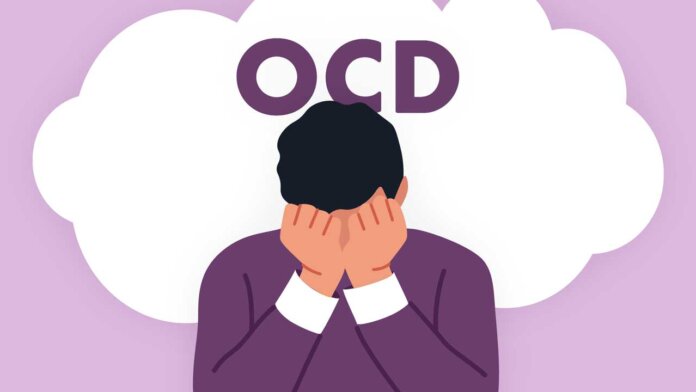Overview
Obsessive-compulsive disorder (OCD) features a pattern of unwanted thoughts and fears known as obsessions. These obsessions lead you to do repetitive behaviors, also called compulsions. These obsessions and compulsions get in the way of daily activities and cause a lot of distress.
Ultimately, you feel driven to do compulsive acts to ease your stress. Even if you try to ignore or get rid of bothersome thoughts or urges, they keep coming back. This leads you to act based on ritual. This is the vicious cycle of OCD.
OCD often centers on certain themes, such as being overly fearful of getting contaminated by germs. To ease contamination fears, you may wash your hands over and over again until they’re sore and chapped.
If you have OCD, you may be ashamed, embarrassed and frustrated about the condition. But treatment can be effective.
Symptoms
Obsessive-compulsive disorder usually includes both obsessions and compulsions. But it’s also possible to have only obsession symptoms or only compulsion symptoms. You may or may not know that your obsessions and compulsions are beyond reason. But they take up a great deal of time, reduce your quality of life, and get in the way of your daily routines and responsibilities.
Obsession symptoms
OCD obsessions are lasting and unwanted thoughts that keep coming back or urges or images that are intrusive and cause distress or anxiety. You might try to ignore them or get rid of them by acting based on ritual. These obsessions usually intrude when you’re trying to think of or do other things.
Obsessions often have themes, such as:
– Fear of contamination or dirt.
– Doubting and having a hard time dealing with uncertainty.
– Needing things to be orderly and balanced.
– Aggressive or horrific thoughts about losing control and harming yourself or others.
– Unwanted thoughts, including aggression, or sexual or religious subjects.
Examples of obsession symptoms include:
– Fear of being contaminated by touching objects others have touched.
– Doubts that you’ve locked the door or turned off the stove.
– Intense stress when objects aren’t orderly or facing a certain way.
– Images of driving your car into a crowd of people.
–Thoughts about shouting obscenities or not acting the right way in public.
– Unpleasant sexual images.
– Staying away from situations that can cause obsessions, such as shaking hands.
Compulsion symptoms
OCD compulsions are repetitive behaviors that you feel driven to do. These repetitive behaviors or mental acts are meant to reduce anxiety related to your obsessions or prevent something bad from happening. But taking part in the compulsions brings no pleasure and may offer only limited relief from anxiety.
You may make up rules or rituals to follow that help control your anxiety when you’re having obsessive thoughts. These compulsions are beyond reason and often don’t relate to the issue they’re intended to fix.
As with obsessions, compulsions usually have themes, such as:
– Washing and cleaning.
– Checking.
– Counting.
– Ordering.
– Following a strict routine.
– Demanding reassurance.
Examples of compulsion symptoms include:
– Hand-washing until your skin becomes raw.
– Checking doors over and over again to make sure they’re locked.
– Checking the stove over and over again to make sure it’s off.
– Counting in certain patterns.
– Silently repeating a prayer, word or phrase.
– Trying to replace a bad thought with a good thought.
– Arranging your canned goods to face the same way.
Severity varies
OCD usually begins in the teen or young adult years, but it can start in childhood. Symptoms usually begin over time and tend to vary in how serious they are throughout life. The types of obsessions and compulsions you have also can change over time. Symptoms generally get worse when you are under greater stress, including times of transition and change. OCD usually thought to be a lifelong disorder, can have mild to moderate symptoms or be so severe and time-consuming that it becomes disabling.
When to see a doctor
There’s a difference between being a perfectionist — someone who needs flawless results or performance — and having OCD. OCD thoughts aren’t simply excessive worries about real issues in your life or liking to have things clean or arranged in a specific way.
If your obsessions and compulsions affect your quality of life, see your doctor or mental health professional.
Causes
The cause of obsessive-compulsive disorder isn’t fully understood. Main theories include:
Biology: OCD may be due to changes in your body’s natural chemistry or brain functions.
Genetics: OCD may have a genetic component, but specific genes have yet to be found.
Learning: Obsessive fears and compulsive behaviors can be learned from watching family members or learning them over time.
Risk factors
Factors that may raise the risk of causing obsessive-compulsive disorder include:
Family history: Having parents or other family members with the disorder can raise your risk of getting OCD.
Stressful life events: If you’ve gone through traumatic or stressful events, your risk may increase. This reaction may cause the intrusive thoughts, rituals and emotional distress seen in OCD.
Other mental health disorders: OCD may be related to other mental health disorders, such as anxiety disorders, depression, substance abuse or tic disorders.
Complications
Issues due to obsessive-compulsive disorder include:
– Excessive time spent taking part in ritualistic behaviors.
– Health issues, such as contact dermatitis from frequent hand-washing.
– Having a hard time going to work or school or taking part in social activities.
– Troubled relationships.
– Poor quality of life.
– Thoughts about suicide and behavior related to suicide.
Prevention
There’s no sure way to prevent obsessive-compulsive disorder. However, getting treated as soon as possible may help keep OCD from getting worse and disrupting activities and your daily routine.
source@mayoclinic.org

